The Villa L'Ambrogiana was a rural palace or villa built during the late-Renaissance by Ferdinand I de' Medici; it is located at the confluence of the rivers Pesa and Arno, in the municipality of Montelupo Fiorentino.
Contents

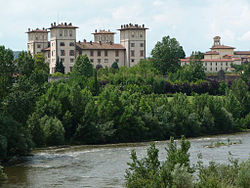
The Villa L'Ambrogiana was a rural palace or villa built during the late-Renaissance by Ferdinand I de' Medici; it is located at the confluence of the rivers Pesa and Arno, in the municipality of Montelupo Fiorentino.


Originally, the site was occupied by a casino owned by the Ardinghetti, who sold it to the Corboli, and then to the Medici. Construction of the present palace took place circa 1587, putatively using designs of Bernardo Buontalenti, and built over a pre-existing structure. [1] In the 19th century, Leopold II converted the villa into a mental asylum. In 1886, it was converted into a jail for women and minors, and later into a jail for those judged mentally ill. The Villa and grounds in the 17th century were used by Francesco Redi for anatomic studies of leprosy, and by Andrea Scacciati and Bartolomeo Bimbi to create paintings of flora and fauna for the Grand-Duke Cosimo III de' Medici.
Still in use as an institution for psychiatric illness, guided visits to parts of the building can be requested. The last patient leaves the Montelupo Fiorentino facility in the first ten days of February 2017,
In the following months the complex returns from the Ministry of Grace and Justice in availability of the State Property Agency.
In 2017, a public tender was published to study a guide plan for the complex, project edited by the winners of the tender, Coopculture and P&M Architecture. . [2]

The Palazzo Pitti, in English sometimes called the Pitti Palace, is a vast, mainly Renaissance, palace in Florence, Italy. It is situated on the south side of the River Arno, a short distance from the Ponte Vecchio. The core of the present palazzo dates from 1458 and was originally the town residence of Luca Pitti, an ambitious Florentine banker.

Villa del Poggio Imperiale is a predominantly neoclassical former grand ducal villa in Arcetri, just to the south of Florence in Tuscany, Central Italy. Beginning as a villa of the Baroncelli of Florence, it was seized by the Medici, became the home of a Medici princess, and a lavish retreat for a Grand Duchess with imperial pretensions. Later given to Napoleon's sister, it was reclaimed by the hereditary rulers of Tuscany before being finally converted to a prestigious girls' school. During its long history, it has often been at the centre of Italy's turbulent history, and has been rebuilt and redesigned many times.

The Teatro della Pergola, sometimes known as just La Pergola, is a historic opera house in Florence, Italy. It is located in the centre of the city on the Via della Pergola, from which the theatre takes its name. It was built in 1656 under the patronage of Cardinal Gian Carlo de' Medici to designs by the architect Ferdinando Tacca, son of the sculptor Pietro Tacca; its inaugural production was the opera buffa, Il potestà di Colognole by Jacopo Melani. The opera house, the first to be built with superposed tiers of boxes rather than raked semi-circular seating in the Roman fashion, is considered to be the oldest in Italy, having occupied the same site for more than 350 years.
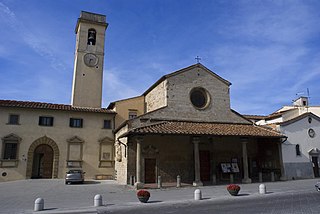
Sesto Fiorentino, known locally as just Sesto, is a commune in the Metropolitan City of Florence, Tuscany, central Italy.

Calenzano is a comune (municipality) in the Metropolitan City of Florence in the Italian region Tuscany, located about 11 kilometres (7 mi) northwest of Florence. As of 31 December 2004, it had a population of 15,557 and an area of 76.9 square kilometres (29.7 sq mi).

Montelupo Fiorentino is a comune (municipality) in the Metropolitan City of Florence in the Italian region of Tuscany, located about 20 kilometres southwest of Florence.

Santa Trinita is a Roman Catholic church located in front of the piazza of the same name, traversed by Via de' Tornabuoni, in central Florence, Tuscany, Italy. It is the mother church of the Vallumbrosan Order of Monks, founded in 1092 by a Florentine nobleman. South on Via de' Tornabuoni is the Ponte Santa Trinita over the river Arno; across the street is the Palazzo Spini Feroni.

Giuseppe Nicola Nasini was an Italian painter of the Baroque period, active in Rome and Tuscany.
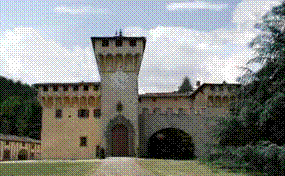
The Villa Medicea di Cafaggiolo is a villa situated near the Tuscan town of Barberino di Mugello in the valley of the River Sieve, some 25 kilometres north of Florence, central Italy. It was one of the oldest and most favoured of the Medici family estates, having been in the possession of the family since the 14th century, when it was owned by Averardo de' Medici. Averardo's son, Giovanni di Bicci de' Medici, is considered to be the founder of the Medici dynasty.

Sant'Apollonia was a former Benedictine convent, founded in 1339, just north of the center of Florence, in Italy.
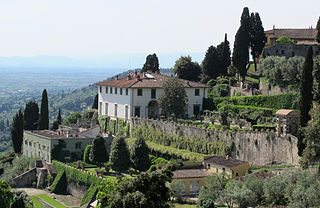
The Medici villas are a series of rural building complexes in Tuscany which were owned by members of the Medici family between the 15th century and the 17th century. The villas served several functions: they were the country palaces of the Medici, scattered over the territory that they ruled, demonstrating their power and wealth. They were also recreational resorts for the leisure and pleasure of their owners; and, more prosaically, they were the centre of agricultural activities on the surrounding estates. In 2013, the Medici villas were added to UNESCO's World Heritage list.
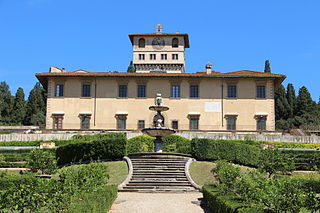
Villa La Petraia is one of the Medici villas in Castello, Florence, Tuscany, central Italy. It has a distinctive 19th-century belvedere on the upper east terrace on axis with the view of Florence.
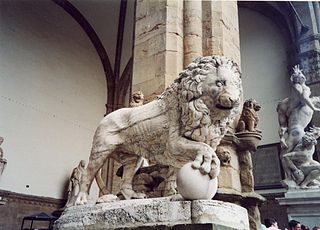
The Medici lions are a pair of marble sculptures of lions: one of which is Roman, dating to the 2nd century AD, and the other a 16th-century pendant. Both were by 1598 placed at the Villa Medici, Rome. Since 1789 they have been displayed at the Loggia dei Lanzi in Florence. The sculptures depict standing male lions with a sphere or ball under one paw, looking to the side.
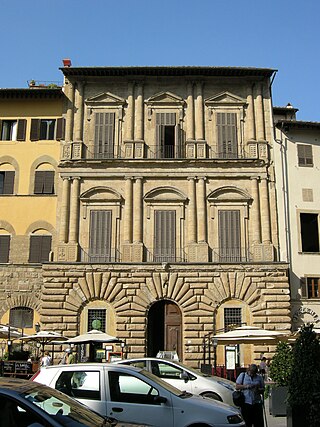
Palazzo Uguccioni is a Renaissance palace on the Piazza della Signoria in Florence, central Italy.

Fabio Mochi, aka MOKI, is an Italian designer, illustrator and publisher.
The Pia Casa di Lavoro di Montedomini is a large complex of buildings in Florence, Italy; the complex took shape in 1812, on the site of two expropriated former monasteries, where the Napoleonic government built a poor-house. The complex is bound by Via dei Malcontenti, Via delle Casine, Via Pietro Thouar and the Viale della Giovine Italia. The complex is located in the quartiere of Santa Croce, east of the city, north of the Arno river, and just within the 16th-century city walls.

The Villa di Marignolle is a Medici villa in the hills between Galluzzo and Soffiano, in the south-western suburbs of the comune of Florence, in Tuscany in central Italy. It passed into the hands of the Medici family after the Pucci Conspiracy, when it was confiscated from Lorenzo di Piero Ridolfi by Francesco I de' Medici, Grand Duke of Tuscany. Francesco passed it to his illegitimate son Antonio.

Villa Corsini a Castello is a suburban villa near Florence, Italy, located in via della Petraia.

The Villa San Girolamo, sometimes known as the Church of San Girolamo, is building complex that includes a villa, olive grove, and former Catholic monastery and church located on Via Vecchia Fiesolana in Fiesole, Tuscany.
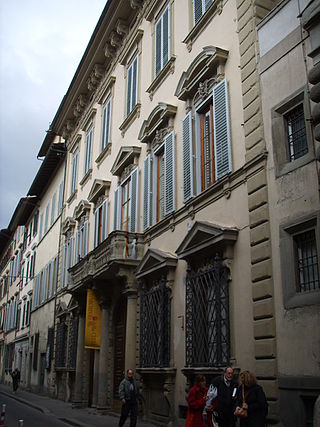
Palazzo Bastogi is located at Via dell'Oriuolo 33 in Florence. It houses the Historical Archive of the City of Florence. The palazzo appears in the list drawn up in 1901 by the General Directorate of Antiquities and Fine Arts as a monumental building to be considered.
43°43′51″N11°00′52″E / 43.73083°N 11.01444°E